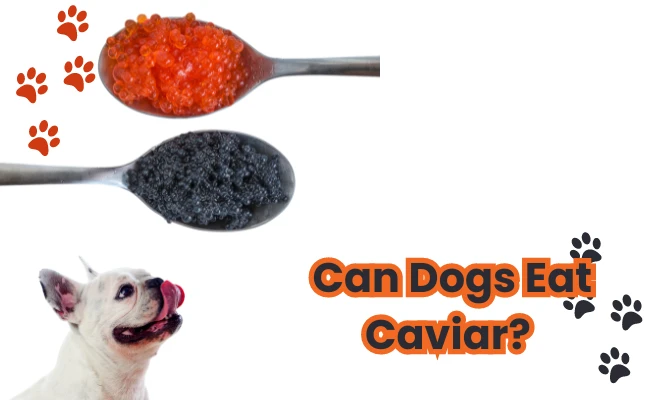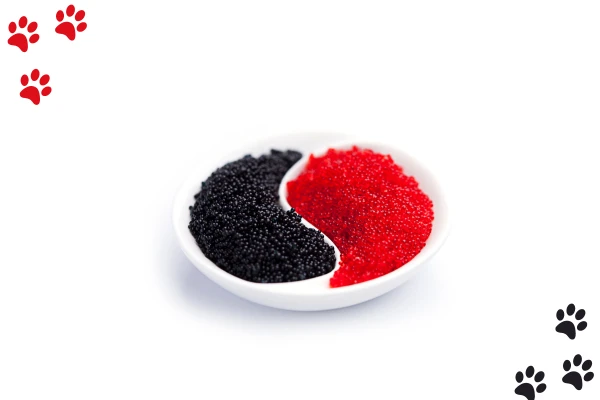
Picture this: you’re indulging in a decadent treat of Imperia Caviar, savoring the buttery texture and rich, oceanic flavors. Suddenly, you notice your furry friend gazing up at you with those irresistible, pleading eyes. You might wonder, “Can dogs eat caviar?” It’s a tempting thought to share a bit of this luxury with your loyal companion. While the answer is yes, it’s important to understand the benefits and risks involved. Before you let your dog partake in this high-end delicacy, let’s explore everything you need to know to ensure it’s a safe and enjoyable experience for both of you.
Table of Contents
- Can Dogs Eat Caviar?
- Nutritional Profile of Caviar
- Health Benefits of Caviar for Dogs
- Potential Risks of Feeding Caviar to Dogs
- How to Safely Introduce Caviar to Your Dog’s Diet
- Selecting the Right Type of Caviar
- Conclusion
Can Dogs Eat Caviar?
Yes, dogs can eat caviar in moderation, but there are important considerations to keep in mind.
Explanation: Caviar can be a safe and occasional treat for dogs due to its rich nutritional profile. It contains beneficial proteins, fats, omega-3 fatty acids, and essential vitamins and minerals that can support your dog’s health. However, caviar is also high in sodium, which can lead to dehydration and other health issues if consumed in large quantities. Therefore, it’s crucial to feed caviar to your dog sparingly, ensuring it remains a special treat rather than a regular part of their diet. Always observe your dog for any adverse reactions and consult your veterinarian before introducing new foods.
Read More: Can Dogs Eat Deviled Eggs?
Nutritional Profile of Caviar

Caviar is not just a luxurious delicacy for humans; it also packs a nutritional punch that can benefit dogs when given in moderation. Understanding its nutritional profile is crucial for making informed decisions about feeding it to your furry friend.
Proteins:
- Amount of Protein in Caviar: A tablespoon of caviar contains about 3.9 grams of protein. This high protein content is beneficial for dogs.
- Importance of Protein for Dogs: Protein is an essential nutrient for dogs, playing a vital role in muscle development, tissue repair, and overall growth. Puppies and working dogs, in particular, need higher amounts of protein to support their active lifestyles and developmental needs.
Salt:
- High Sodium Content in Caviar: Caviar is known for its high sodium content, which contributes to its unique flavor.
- Potential Risks of High Sodium Intake for Dogs: While some sodium is necessary for bodily functions, too much can be harmful. Excessive salt can lead to increased thirst, dehydration, and, in severe cases, sodium poisoning. Therefore, it’s important to limit the amount of caviar your dog consumes to prevent these health issues.
Fats:
- Types of Fats in Caviar: Caviar contains healthy fats, including monounsaturated and polyunsaturated fats.
- Monounsaturated Fats: These fats can help increase high-density lipoprotein (HDL) cholesterol, which is beneficial for heart health.
- Polyunsaturated Fatty Acids (PUFAs): These include omega-3 fatty acids, which support cardiovascular health, reduce inflammation, and promote a shiny coat and healthy skin.
- Health Benefits of These Fats for Dogs: Healthy fats are crucial for energy, cell function, and nutrient absorption. They also play a role in maintaining healthy skin and a shiny coat, as well as supporting brain and heart health.
Carbohydrates:
- Low Carbohydrate Content: Caviar is low in carbohydrates, which makes it a suitable treat for maintaining your dog’s weight.
- Benefits for Maintaining a Healthy Weight: A low carbohydrate content helps prevent unnecessary weight gain and supports a balanced diet. Dogs primarily need protein and fats for energy, making low-carb treats like caviar a better option for occasional indulgence without contributing to obesity.
By understanding these nutritional components, you can better appreciate the benefits and potential risks of sharing caviar with your dog. Remember, moderation is key to ensuring your dog enjoys this special treat safely.
Read More: Can Dogs Eat Sloppy Joes? Potential Risks and Safe Alternatives
Health Benefits of Caviar for Dogs
Caviar is not only a luxurious treat but also a nutrient-dense food that can offer several health benefits for your dog. Here’s a closer look at the key components:
Omega-3 Fatty Acids:
- Benefits for Skin and Coat: Omega-3 fatty acids help maintain a healthy, shiny coat and prevent dry, itchy skin. They support the skin’s natural barrier, keeping it hydrated and reducing inflammation.
- Benefits for Joints: These fatty acids have anti-inflammatory properties that can alleviate joint pain and stiffness, making them particularly beneficial for older dogs or those with arthritis.
- Benefits for Cognitive Function: Omega-3s support brain health, enhancing cognitive functions and memory. They are crucial for the development of puppies’ brains and can help maintain cognitive function in senior dogs.
Vitamins and Minerals:
- Presence of Vitamins C, E, A, B12, and Iron: Caviar is rich in essential vitamins and minerals that contribute to overall health.
- Vitamin C: An antioxidant that boosts the immune system, helps in collagen production, and supports wound healing.
- Vitamin E: Another antioxidant that protects cells from damage, promotes healthy skin and coat, and supports immune function.
- Vitamin A: Essential for vision, immune health, and cell growth. It also plays a role in maintaining healthy skin.
- Vitamin B12: Important for nerve function, red blood cell production, and DNA synthesis. It helps convert food into energy, supporting overall metabolism.
- Iron: Crucial for the production of hemoglobin, which carries oxygen in the blood. It also supports immune function and cognitive development.
Role of These Vitamins and Minerals:
- Boosting Immunity: Vitamins C and E enhance the immune system by protecting cells from oxidative stress and supporting overall immune function.
- Red Blood Cell Production: Vitamin B12 and iron are vital for producing healthy red blood cells, which are necessary for transporting oxygen throughout the body.
- Overall Health: These nutrients collectively support various bodily functions, contributing to your dog’s vitality and well-being. They aid in energy production, support healthy growth and development, and help maintain a balanced diet.
By incorporating small amounts of caviar into your dog’s diet, you can provide these essential nutrients, enhancing their health in multiple ways. However, due to its high sodium content, caviar should be given as an occasional treat rather than a regular part of their diet.
Read More: Can Dogs Eat Potted Meat? A Comprehensive Guide
Potential Risks of Feeding Caviar to Dogs
While caviar can offer several health benefits, it also comes with potential risks that dog owners need to be aware of. Understanding these risks is crucial for ensuring your dog’s safety and well-being.
High Sodium Content:
- Risks of Dehydration: Caviar is high in sodium, which can lead to increased thirst and dehydration in dogs. Excessive salt intake can disrupt the body’s fluid balance, causing your dog to drink more water to compensate.
- Salt Toxicity: In severe cases, too much sodium can lead to salt toxicity. Symptoms of salt toxicity include vomiting, diarrhea, lethargy, tremors, seizures, and even death if not treated promptly. Dogs consuming more than two grams of salt per pound of body weight are at serious risk.
Allergic Reactions:
- Possibility of Allergies or Sensitivities: Just like humans, dogs can have allergies or sensitivities to certain foods, including fish eggs. Allergic reactions can range from mild to severe and may include symptoms like itching, swelling, hives, gastrointestinal upset, or respiratory issues. If your dog shows any signs of an allergic reaction after consuming caviar, discontinue feeding it immediately and consult your veterinarian.
Overconsumption:
- Importance of Moderation: Overfeeding caviar to your dog can lead to several health issues beyond sodium toxicity. Given its rich and fatty nature, excessive consumption can result in gastrointestinal distress, including vomiting and diarrhea. Moreover, the high-calorie content of caviar can contribute to weight gain and obesity if not fed in moderation.
- Balanced Diet Considerations: It’s important to treat caviar as a special, occasional treat rather than a regular part of your dog’s diet. A balanced diet that meets all nutritional needs is essential for your dog’s health. Overindulgence in any treat, including caviar, can disrupt this balance and lead to nutritional deficiencies or imbalances.
By being mindful of these potential risks and feeding caviar in controlled, moderate amounts, you can safely enjoy sharing this luxurious treat with your dog without compromising their health. Always monitor your dog’s reaction to new foods and consult your veterinarian if you have any concerns about their diet.
Read More: Can Dogs Eat Lemon Pepper? What Pet Owners Need to Know
How to Safely Introduce Caviar to Your Dog’s Diet
Introducing caviar to your dog’s diet can be done safely by following a few key guidelines. Here’s how to ensure your dog enjoys this treat without any adverse effects.
Moderation:
- Recommended Serving Sizes: When offering caviar to your dog, it’s essential to keep the portion size small. A teaspoon to a tablespoon of caviar is generally sufficient, depending on the size of your dog. Smaller breeds should receive the lower end of this range, while larger breeds can have a slightly larger amount. This helps to minimize the intake of sodium and other nutrients that can be harmful in large quantities.
- Frequency of Feeding: Due to its high sodium content, caviar should not be a regular part of your dog’s diet. Instead, consider it a special treat that can be given occasionally. Feeding caviar once or twice a week is a good rule of thumb. This frequency allows your dog to enjoy the benefits of caviar without the risks associated with overconsumption.
By adhering to these guidelines, you can introduce caviar into your dog’s diet safely, ensuring that it remains a delightful and healthy treat rather than a dietary hazard. Always observe your dog for any signs of adverse reactions when introducing new foods and consult your veterinarian if you have any concerns.
Read More: The Hilarious Truth About Crusty White Dogs in Every Rich Family’s Mansion
Selecting the Right Type of Caviar
Ossetra Caviar:
- Description of Flavor and Texture: Ossetra caviar is known for its nutty flavor and firm texture. The eggs range in color from dark brown to golden, and they burst in the mouth with a rich, briny taste. This type of caviar is considered one of the finest and is a luxurious choice for both humans and dogs.
Kaluga Hybrid Reserve:
- Description of Flavor and Lower Salt Content: Kaluga Hybrid Reserve caviar offers a beautifully buttery flavor with a less salty taste compared to other types of caviar. The eggs are large and light to dark brown in color. The lower salt content makes this type of caviar a slightly safer option for dogs, reducing the risk of sodium-related health issues.
Other Considerations
Sustainability:
- Importance of Choosing Sustainably Harvested Caviar: When selecting caviar, it’s important to choose products that are sustainably harvested. Sustainable practices ensure that caviar production does not harm the environment or deplete fish populations. Look for brands that are committed to ethical sourcing and environmental stewardship.
Quality Treats:
- Emphasizing Caviar as a High-Quality, Occasional Treat: Caviar is a high-quality, nutrient-rich treat that should be given to your dog sparingly. Emphasize its status as an occasional indulgence rather than a regular part of their diet. This approach helps maintain your dog’s overall health and prevents any potential negative effects from overconsumption.
Read More: Can Dogs Eat Sloppy Joes? Potential Risks and Safe Alternatives
Conclusion
Recap of Key Points:
- Caviar can be a safe and beneficial treat for dogs when given in moderation.
- It offers valuable nutrients such as proteins, omega-3 fatty acids, and essential vitamins and minerals.
- The high sodium content of caviar necessitates careful portion control to avoid health risks.
- Selecting the right type of caviar, like Ossetra or Kaluga Hybrid Reserve, can enhance your dog’s experience.
Final Thoughts on Responsibly Sharing Caviar with Your Dog:
- Always monitor your dog for any adverse reactions when introducing caviar or any new food.
- Consult with your veterinarian to ensure caviar is a suitable treat for your dog’s specific dietary needs.
- Treat caviar as a rare and special delight, reinforcing the bond between you and your pet while prioritizing their health and well-being.
FAQs
Can All Dogs Eat Caviar?
- While most dogs can safely eat caviar in small amounts, it is not suitable for all dogs. Dogs with specific health conditions, dietary restrictions, or allergies may not tolerate caviar well. Always consult your veterinarian before introducing new foods.
What Should I Do If My Dog Reacts Badly to Caviar?
- If your dog shows signs of an adverse reaction, such as vomiting, diarrhea, itching, or swelling, stop feeding caviar immediately and consult your veterinarian. Provide fresh water and monitor your dog closely for any worsening symptoms.
Are There Other Fish-Based Treats I Can Give My Dog?
- Yes, there are many fish-based treats that are safe and nutritious for dogs. Options include salmon, sardines, and fish oil supplements. These alternatives can offer similar health benefits without the high sodium content found in caviar. Always ensure any fish treats are free of bones and cooked properly to avoid any potential hazards.



